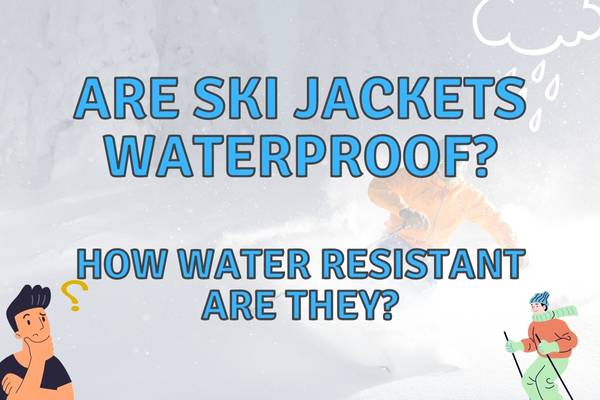Are jackets commonly used for skiing waterproof? This is a question that many outdoor enthusiasts and skiers ask.
I personally use my skiing jacket for hiking as well as skiing, so knowing about it rain-proof capabilities is a must!
Down jackets have become increasingly popular for skiing in recent years due to their lightweight, warm insulation and ability to be easily packed away for travel. And whereas most down jackets are treated with DWR to repel water, they are not actually waterproof! However, depending on the outer layer, most skiing jackets are quite water resistant, and variants with built-in breathable shells like GoreTex do exist.
It is important to know how water resistant your skiing jacket is, especially if it contains down, as water may not only ruin its warmth temporarily, but might risk permanently damaging the down inside!
Contents
Are Ski Jackets Waterproof Enough for Rain?
Ski jackets are designed to keep you warm and dry while skiing, but depending on their material, they might not keep you dry in heavy rain showers.
Ski jackets feature a variety of fabrics that help make them water-resistant or even completely waterproof.
To know if you ski jacket is waterproof, or just water resistant, you need to know what type of jacket you are wearing.
There are several types of ski jackets available, including:
- Insulated Parka Type Jacket: These jackets are designed to keep the wearer warm in cold temperatures. They have a layer of insulation, such as down or synthetic material, that traps heat to keep the body warm. They are typically made of warm breathable material rather than a waterproof shell.
- Softshell Ski Jacket: Softshell jackets or windbreakers are made of a stretchy and breathable material that is water-resistant, but not completely waterproof. They are perfect for milder weather conditions and are suitable for activities like cross-country skiing and snowshoeing.
- Hard Shell Ski Jacket: These jackets are designed to be worn over other layers and are made of a waterproof and breathable material. They are lightweight and provide protection from the elements, but do not have any insulation. They are suitable for activities like backcountry skiing and mountaineering.
- 3-in-1 Ski Jacket: These jackets can be worn in three different ways – as a shell, as an insulated jacket, or as a combination of both. They have a detachable insulated liner that can be removed for warmer weather, or worn on its own for milder conditions.
- Technical Ski Jacket: These jackets are designed for advanced skiers and snowboarders. They have a variety of features, such as adjustable hoods, multiple pockets, and ventilation zippers, to make them suitable for high-intensity activities. They are typically made of a waterproof and breathable material to keep the wearer dry and comfortable.
- Puffer Ski Jacket: These jackets are designed to provide maximum warmth and are filled with synthetic or down insulation. They are perfect for extremely cold temperatures and are suitable for activities like backcountry skiing and mountaineering. They are typically made of a waterproof and breathable material to keep the wearer dry and comfortable.
Common to them all is that the outer layer of most ski jackets is made from nylon or polyester fabric with a durable water repellent (DWR) coating applied to the exterior.
This DWR coating helps repel moisture and prevents it from seeping through the fabric, keeping you dry in wet conditions. Some ski jacket manufacturers also add additional layers such as Gore-Tex for extra protection against rain and snow.
| Jacket Type | Rain Resistance |
|---|---|
| Parka Type Jacket | Low-Medium |
| Softshell Ski Jacket | Low |
| Hard Shell Ski Jacket | Very High |
| 3-in-1 Ski Jacket | Low to High |
| Technical Ski Jacket | High |
| Puffy Ski Jacket | Medium (If DWR) |
In addition to the outer layer of fabric, many ski jackets also have an inner lining that helps keep you warm by trapping body heat inside the jacket while preventing cold air from entering.

These linings can be made from synthetic materials like polyester fleece or down feathers which provide excellent insulation without adding too much bulkiness or weight to your jacket.
Do ski jackets need to be waterproof?
The answer is not clear cut and depends on the type of skiing you plan to do – and where you plan to do it!
If you plan on going skiing where temperatures fluctuate above freezing point, I would recommend going for a waterproof skiing jacket. But if you stay in an area where there is virtually not chance of wet snow or rain – don’t bother with a rain proof jacket!
For downhill skiing in warmer areas, it’s important that your ski jacket is waterproof. This is because there may be a great deal of difference in temperatures between the top of the mountain and down where you end up!
Downhill skiing usually involves wet snow or rain, so having a waterproof jacket will help keep you dry and warm while out on the slopes. Ski jackets made from Gore-Tex fabric are especially good at keeping water out as this material is designed specifically for outdoor activities in wet conditions.
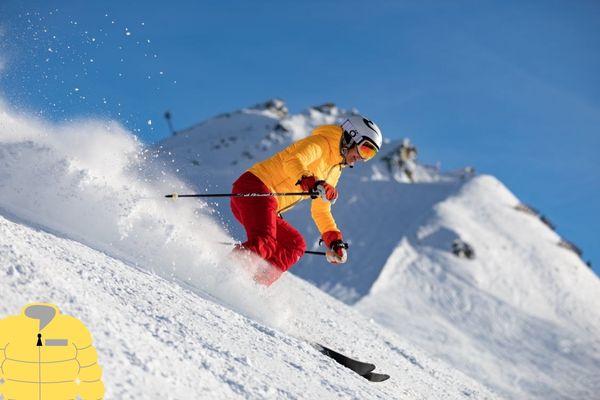
If you’re planning on cross country skiing or backcountry touring then I would not prioritize a fully waterproof ski jacket.
Why? Because they come a too large a cost in terms of breathability and you sure want a breathable jacket for cross country!
However, some degree of water resistance can still be beneficial depending on the weather conditions and terrain you plan to cover during your trip.
A lightweight shell jacket or windbreaker with DWR (durable water repellent) coating can provide enough protection against light showers without adding too much weight or bulkiness to your gear list.
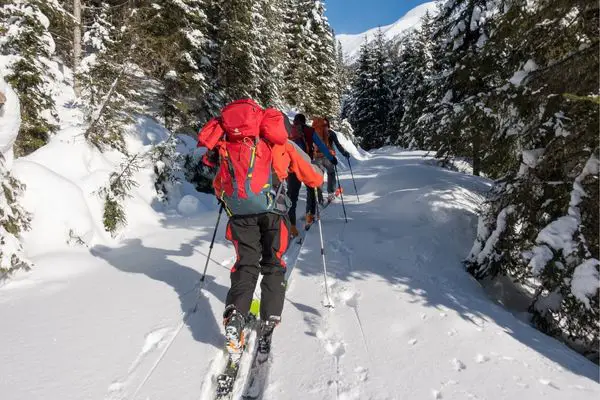
It’s also worth noting that even if your ski jacket isn’t 100% waterproof it should still offer breathability so sweat doesn’t build up inside the garment when temperatures rise.
Finally, if all else fails and none of these options seem suitable for what you have planned then layering up with multiple garments may be an option instead.
Start off with a base layer followed by an insulating mid layer such as fleece or a good down puffer jacket, if really cold, before finally topping off with a windproof outer shell which will protect against most types of precipitation whilst allowing excess heat and moisture escape from within its layers.
Making sure each piece fits snugly together will ensure maximum warmth retention throughout your adventure.
Although ski jackets do not need to be waterproof, it is important to consider the level of water resistance that your jacket offers when selecting a jacket for outdoor activities. Next, we will explore how down jackets compare in terms of their waterproofing capabilities.
Key Takeaway: For downhill skiing, it’s important to have a waterproof ski jacket such as one made from Gore-Tex fabric. For other activities such as cross country skiing or backcountry touring, a lightweight shell with DWR coating can provide enough protection against light showers, while still being breathable enough.
How waterproof are Jackets Used for Skiing?
Most ski jackets are constructed using either down feathers, synthetic insulation materials such as Primaloft®, Thinsulate™ ,or Polartec®, fleece fabrics, Gore-Tex® membranes, or other similar waterproof/breathable technologies.
Down filled jackets generally do not provide much protection against wet weather since down absorbs moisture easily; however these can be paired up with an outer shell layer made from one of the aforementioned materials for added protection against precipitation when needed.
On the other hand, synthetic insulated jackets tend to have better water resistance due their ability to repel liquid away from their surface area even when subjected to prolonged exposure.
Additionally, Gore-Tex® membranes provide superior levels of both breathability and waterproofness making them ideal for use in extreme winter sports activities where keeping dry is essential.
However, the exact level of waterproofing will vary depending on the specific jacket and its construction.
| Material | Brand | Material | Waterproof Rating | Main Features |
| Columbia Bugaboo Interchange Jacket | Columbia | Nylon (OmniTech) | 15,000mm | Interchangeable layers, adjustable hood, zippered pockets |
| The North Face Freedom Jacket | The North Face | Polyester | 5,000mm | Adjustable powder skirt, wrist gaiters, goggle pocket |
| Patagonia Powder Bowl Jacket | Patagonia | Gore-Tex | 20,000mm | Fully-taped seams, underarm vents, removable hood |
| Arc’teryx Sentinel Jacket | Arc’teryx | Gore-Tex | 30,000mm | Waterproof zippers, wrist gussets, powder skirt |
| Spyder Leader Jacket | Spyder | Polyester | 10,000mm | Removable hood, zippered chest and hand pockets, powder skirt |
| Helly Hansen Powderqueen Jacket | Helly Hansen | Polyester | 20,000mm | Insulated, adjustable hood and hem, zippered pockets |
| Roxy Jetty Jacket | Roxy | Nylon | 10,000mm | Critically-taped seams, removable hood, interior goggle pocket |
| Obermeyer Quantum Jacket | Obermeyer | Polyester | 15,000mm | Detachable hood, zippered pockets, interior goggle pocket |
| Mountain Hardwear Snowtastic Jacket | Mountain Hardwear | Nylon | 10,000mm | Adjustable hood, wrist gaiters, zippered pockets |
| Volcom L Gore-Tex Jacket | Volcom | Gore-Tex | 25,000mm | Fully-taped seams, underarm vents, removable hood |
| Arc’teryx Sabre Jacket | Arc’teryx | Gore-Tex | 30,000mm | Waterproof zippers, wrist gussets, powder skirt |
| Patagonia Primo Jacket | Patagonia | Gore-Tex | 20,000mm | Fully-taped seams, underarm vents, removable hood |
| The North Face Arctic Parka | The North Face | DryVent | 15,000mm | Insulated, adjustable hood and hem, zippered pockets |
| Columbia Whirlibird Interchange Jacket | Columbia | Nylon | 10,000mm | Interchangeable layers, adjustable hood, zippered pockets |
| Marmot Spire Jacket | Marmot | GORE-TEX | 20,000mm | Fully-taped seams, zippered pockets, adjustable waist |
| Helly Hansen Legendary Jacket | Helly Hansen | Polyester shell | 25,000mm | Insulated, adjustable hood and hem, zippered pockets |
| Roxy Creek Jacket | Roxy | Nylon | 15,000mm | Critically-taped seams, removable hood, interior goggle pocket |
| Mountain Hardwear Snowburst Jacket | Mountain Hardwear | Nylon | 10,000mm | Helmet compatible hood, Fixed adjustable powder skirt. |
As seen from the table above, most skiing jackets are made to be somewhat waterproof with at least a 5000 mm water column water resistance.
This means that they can be used in light rain showers, but fairly heavy snowfall as snow is not as “wet” as rain.
If the shell material is thicker, or a multi-layered GoreTex shell is involved, then a skiing jacket can be up to 30000 mm waterproof, which is good enough for even the heaviest rainfalls.
How do I know if my ski jacket is waterproof?
When trying to assess the waterproof capabilities of a ski jacket, there are a few key indicators to look out for. One way to gauge the jacket’s ability to repel water is by checking for a waterproof rating, such as 5,000mm or 10,000mm, on the jacket’s tag or in its product description.
This measurement represents the maximum amount of water pressure the jacket can withstand before water begins to seep through.
Additionally, one should inspect the jacket’s construction, specifically if it is made with waterproof and breathable materials, such as Gore-Tex, which will aid in keeping you dry and comfortable while skiing.
An alternative way to check the jacket’s water resistance is by performing a simple test where you pour water on the jacket and observe if the water is able to penetrate the jacket or not.
What Are Ski Jackets Made From?
Ski jackets come in many different materials depending on the level of warmth and protection desired by the wearer.
Commonly used materials include down feathers, synthetic polyester insulation, fleece, Gore-Tex®, and other waterproof membranes. Down feathers provide excellent insulation for cold temperatures but lack any kind of water resistance so they must be paired with an outer shell layer, typically nylon or polyester, to protect against rain or snowfall.
Synthetic insulations offer good warmth without being too bulky or heavy; however, some types may absorb moisture if exposed to wet weather conditions for long periods of time.
Fleece is lightweight yet warm and provides some degree of breathability; however it does not offer any kind of waterproofing unless combined with another material such as Gore-Tex® or other membrane layers that block out moisture while still allowing air circulation inside the jacket itself.
Finally, some ski jackets come with taped seams which help prevent moisture from seeping through any small gaps between panels of fabric on your jacket where two pieces join together at a seam line.

Overall, modern ski jackets provide good protection against wind and rain. This is due to their combination of high quality fabrics and special features such as taped seams and DWR waterproofing coatings.
These help keep out moisture while still allowing breathability so you don’t overheat during strenuous activities like skiing down slopes at high speeds.
However, as the shell itself is often just a thin nylon layer, they are not enough to keep out heavy rain.
Down jackets are a great way to stay warm and dry while out on the trails, but it is important to understand that not all down jackets are waterproof.
The next heading will discuss what materials make up a ski jacket and how they can affect its waterproofing capabilities.
Key Takeaway: Modern ski jackets are designed to keep you warm and dry in wet conditions. They feature a variety of fabrics, such as nylon or polyester with DWR coatings, inner linings like fleece or down feathers for insulation, and taped seams for extra protection. With these features combined, ski jackets provide excellent protection against wind and rain while still allowing breathability so you can stay comfortable during outdoor activities.
What is the Shell of A Ski Jacket Made From?
Ski jackets typically consist of a synthetic outer shell, usually made from nylon or polyester, and an insulation layer filled with down or synthetic material like polyester. The insulation helps trap body heat so you stay warm even in cold temperatures.
The outer shell is the most important part of a ski jacket as it keeps out moisture and wind. It should be breathable, meaning it allows air to pass through but not water vapor, so your sweat can evaporate without getting wet inside the jacket.
The outer shell can be made from one or more layers of synthetic material such as nylon or polyester. Polyester is most common and provide a good trade-off between water/snow resistance and fairly good breathability while also keeping heat in.
Although polyester and nylon is often used in rain gear, it is not 100% waterproof even when treated with surface waterproofing chemicals.
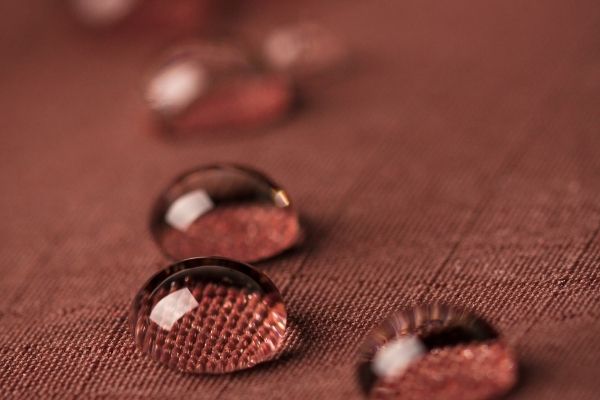
Many ski jackets use Gore-Tex fabric for this purpose because it’s waterproof and breathable, however it is not as breathably as nylon or polyester alone.
Other materials used include Pertex Shield+ which is also very light and durable; eVent which is more expensive but offers superior breathability; SympaTex which has excellent weather protection; Polartec NeoShell which provides good stretchiness; and HyVent DT which has great durability against wear-and-tear damage.
In addition to being waterproof, ski jackets need to be windproof too since strong winds can easily penetrate regular fabrics like cotton or woolen fabrics that don’t have any protective coating on them.
To make sure your jacket is windproof look for features such as taped seams (which prevent air from entering through small holes) or drawstrings at the waistband (to tighten up the fit).
Some brands may also add extra layers of fabric around areas prone to wind penetration such as zippers or pockets – these are called baffles – for added protection against chilly gusts of air!

Finally, some ski jackets come with additional features such as removable hoods (for when you don’t need extra warmth), adjustable cuffs (to keep out drafts), internal pockets (for storing items securely) and reflective details (so you remain visible in low light conditions).
All these elements help create a comfortable experience while skiing by keeping the wearer warm, dry and safe regardless of the weather.
Ski jackets are typically made from a combination of materials such as polyester, nylon, and down feathers that provide warmth and protection against the elements. Next, we’ll look at how waterproof these ski jackets can be.
Key Takeaway: A key takeaway from the above is that ski jackets need to be both waterproof and windproof in order to provide maximum protection against cold temperatures. To ensure this, look for features such as taped seams, drawstrings at the waistband, Gore-Tex fabric or other breathable materials like Pertex Shield+, eVent, SympaTex or Polartec NeoShell. Additional features such as removable hoods, adjustable cuffs and reflective details are also useful for comfort and safety while skiing.
Can you Use a Rain Jacket for Skiing?
Rain jackets are a great option for hikers and outdoor enthusiasts who want to stay dry in wet weather.
But when it comes to skiing, rain jackets may not be the best choice if the weather is really cold.
While they can provide some protection from light rain or snow, they don’t offer the same insulation as a ski jacket with down fill.

Ski jackets are designed specifically for cold-weather activities like skiing and snowboarding. They are usually made of waterproof materials such as Gore-Tex or other breathable fabrics that help keep you warm while still allowing your body heat to escape so you don’t overheat.
Ski jackets also have features like adjustable hoods, cuffs, and drawstrings that help keep out wind and snow while keeping you comfortable on the slopes.
Down is another important feature of ski jackets because it provides extra warmth without adding bulkiness or weight.
Down filled ski jackets will keep you warmer than any other type of coat in cold weather conditions making them ideal for winter sports activities like skiing and snowboarding where temperatures can drop quickly at higher altitudes.
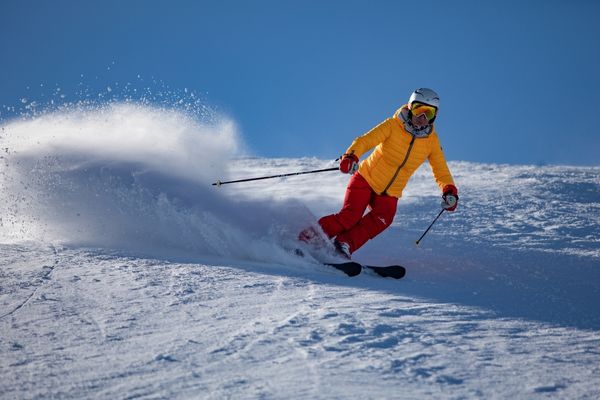
Rain coats typically won’t provide enough insulation against freezing temperatures found at higher elevations while most ski coats come with additional features such as pit zips, powder skirts, wrist gaiters etc.
This make them more suitable for colder climates where temperature drops drastically throughout the day due to changing elevation levels on mountainsides .
In conclusion, if you plan on taking part in winter sports activities then investing in an insulated down filled ski jacket is definitely worth considering since it will provide much better protection against harsh elements found up high compared to regular raincoats meant only for everyday use during milder seasons.
Rain jackets are designed to keep you dry in wet conditions, but they may not be suitable for skiing due to the lack of insulation.
Key Takeaway: Down filled ski jackets are ideal for winter sports activities like skiing and snowboarding because they provide better insulation against cold temperatures than raincoats. They also come with additional features such as pit zips, powder skirts, wrist gaiters etc., which make them more suitable for colder climates where temperature drops drastically throughout the day due to changing elevation levels on mountainsides.
What is the Difference Between a Ski Jacket and a Rain Jacket?
Choosing between a ski jacket and a rain jacket can be difficult as they both offer protection from the elements.
The main difference between a rain jacket and a ski jacket is their ability to protect against extreme temperatures and wet conditions on the mountain slopes compared to just light precipitation during hiking trips or everyday wear in milder climates.
However, there are key differences that make each one better suited for different conditions.
Material
The material used in ski jackets is designed to keep you warm even when wet, while rain jackets are made of waterproof materials such as nylon or polyester that repel water but don’t provide much insulation.
Ski jackets usually contain down or synthetic down fillings which help trap heat and keep you warm even in cold temperatures.
Rain jackets on the other hand are often just a lightweight and thin polyester or nylon shell so they won’t add bulk or weight when worn over other layers of clothing like sweaters or hoodies.
Breathability
Ski jackets have more breathable fabrics that allow air to circulate through them so your body temperature stays regulated during strenuous activity like skiing or snowboarding.
Rain coats typically do not prioritize this feature since their main purpose is to protect against moisture rather than regulate body temperature.
Durability
Rain coats tend to be more durable than ski jackets because they’re made with thicker materials like nylon and polyester which can withstand wear and tear better than thinner fabrics found in ski apparel such as fleece liners or softshells.
On the other hand, some ski jackets come with reinforced seams for extra durability which makes them great for more extreme weather conditions like snowstorms where wind chill can be an issue too!
Style & Design
Raincoats generally have a more basic design compared to skiwear which often has features such as adjustable cuffs, drawstrings at the waistline , pockets etc., making it easier for you to customize your look according to your needs.
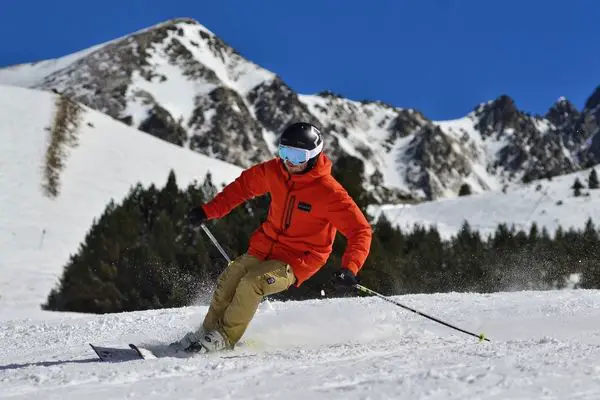
Skiwear also tends to come in brighter colors and patterns whereas raincoats usually stick with neutral tones such as black , navy blue etc.. So if style matters then choose accordingly!
In conclusion, although both types of outerwear serve similar purposes – protecting us from harsh weather – there are distinct differences between them that should be taken into consideration before making a purchase decision.
Ski Jackets offer warmth due to their insulated filling while being breathable enough for strenuous activity; however, if all-weather protection is what you need then go ahead with a raincoat instead.
Ski jackets are designed to be lightweight and provide warmth, while rain jackets are made with waterproof materials that can keep you dry in wet conditions.
Key Takeaway: When it comes to outdoor activities, ski jackets and raincoats are both great options for protecting against the elements. Ski jackets provide warmth due to their insulated filling and breathability, while raincoats offer waterproof protection with a more basic design.
How to waterproof ski jacket?
But even the best ski jacket can become saturated with water if it isn’t properly waterproofed. To ensure your ski jacket is ready for whatever Mother Nature throws at you, here are some tips on how to waterproof a ski jacket.
Durable Water Repellent (DWR) Detergents: DWR detergents are specifically designed to restore the water-repelling properties of synthetic fabrics such as nylon and polyester that make up most ski jackets.
Simply follow the instructions on the bottle when washing your jacket and then tumble dry it on low heat or air dry it outside until completely dry before using again.
Sprays: Sprays offer an alternative way of restoring a coat’s water repellency without having to wash it first.
Spray-on products work by forming a protective coating over each individual fiber of fabric which helps repel moisture from penetrating through the material while also allowing vapor molecules created by body heat to escape outwards so that you don’t get too hot inside your coat either!
I have gone through many other methods on how to waterproof your outdoor apparel in my recent post here.
Cotton Based Jackets: Waxing is another option for waterproofing cotton based jackets like Fjällrävens popular models made from G-1000 fabric which contains 65% recycled polyester and 35% organic cotton fibers blended together into one durable material perfect for outdoor activities like skiing!
To wax these types of coats, simply apply an appropriate wax product evenly across all surfaces including seams where possible before buffing off any excess with a soft cloth or brush – this will help create an extra layer of protection against rainwater penetration while still maintaining breathability levels so that you stay comfortable during those long days spent outdoors!
In addition to these methods there are also many wash-in waterproofing detergents that work really well if you need to wash you jacket anyways!
No matter what type of coat you have, taking steps towards making sure it is waterproofed correctly will go a long way in keeping yourself protected from wintery conditions while enjoying time spent outdoors skiing or hiking in colder climates.
Regular maintenance may be required depending on how often you use your coat throughout different seasons, and this care not only extends its life but also ensures maximum performance when needed most.
Waterproofing your ski jacket is an important part of staying warm and dry while out on the slopes. Now, let’s look at how to choose the right down jacket for your needs.
Key Takeaway: Waterproofing a ski jacket is essential for keeping warm and dry in cold, wet weather. To do so, use DWR detergents when washing or spray-on products to restore water repellency without having to wash it first. For cotton based jackets, a wax layer is also a good option.
Down Jackets vs. Synthetic Fill Jackets
Down jackets are a great choice for hikers and outdoor enthusiasts who need to stay warm in cold weather.
Down jackets offer superior insulation compared to synthetic fill jackets, making them ideal for those who spend long periods of time outdoors in the winter months.
In fact, my recent investigations show that down-filling is approximately 20% colder compared to down when used in the winter jackets of top outdoor brands.
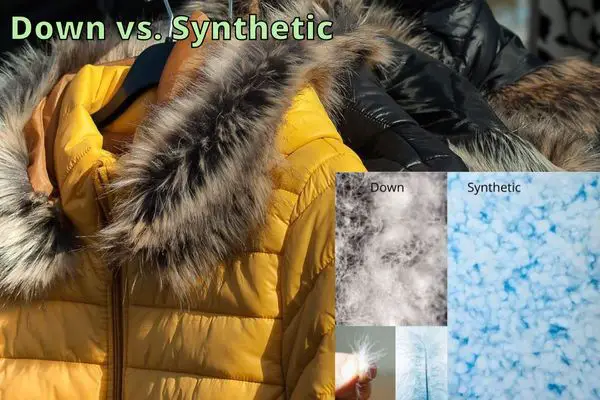
Down is lightweight and can be compressed easily, so it’s easy to carry with you on your hikes or camping trips.
However, down does have one major downside: when wet, its insulating ability is greatly reduced.
It also takes a very long time to dry out once it gets wet. For this reason, waterproof down jackets are recommended over regular ones if you plan on spending any amount of time outdoors during rainy conditions.
The key lies in the type of down used and if it is treated with a waterproofing agent or not.
On top of these down feathers, most jackets feature a waterproof coating or fabric such as polyester or nylon to further protect against moisture penetration.
Additionally, pockets that contain the down may also have some sort of water resistance built into them for extra protection from wet weather conditions.
When it comes to construction techniques that make a jacket more waterproof, there are several factors at play here too – including seam taping (the process by which seams between panels are sealed off) and DWR (durable water repellent) coatings applied to fabrics during manufacturing processes.
Waterproof down jackets feature seam-sealed construction that prevents water from entering the garment at all costs – something that synthetic fill coats cannot provide as effectively.
When deciding between a down jacket and a synthetic fill jacket, consider what kind of environment you will be skiing in most often and how much warmth you need from your coat – and how much you want to pay!
If rain is likely an issue then go with the waterproof option; otherwise regular down may suffice depending on how cold it gets where you live or travel to frequently.
Synthetic fill coats offer some advantages too such as being more durable than their feathery counterparts.
Down puffer jackets are also more complicated to fluff up after washing, which is less of a problem with synthetic puffer jackets.
But they don’t quite match up when it comes to heat retention capabilities like down does so keep that in mind before making your purchase decision!
FAQs
What happens if skiing jacket with down jacket gets wet?
If a down jacket gets wet, it will lose its insulating properties and become much less effective at keeping you warm. The feathers in the down can clump together when wet, creating cold spots and reducing the overall warmth of the garment.
Additionally, if not dried properly, a wet down jacket can start to smell unpleasant due to bacteria growth. To prevent this from happening, it is important to waterproof your down jacket before heading out on any outdoor adventures.
If your down jacket does get wet while hiking or camping, make sure to dry it as soon as possible by hanging it up in a well-ventilated area away from direct heat sources.
Is down good for wet weather?
Yes, down is a great choice for wet weather. It has excellent insulating properties and can keep you warm even when it’s damp or wet outside. Down also dries quickly so you won’t be left feeling cold and uncomfortable after getting caught in the rain.
Additionally, down is lightweight and compressible which makes it easy to pack away when not in use.
All of these features make down an ideal material for hikers and outdoor enthusiasts who are looking for reliable insulation during their adventures in any kind of weather conditions.
Conclusion
In conclusion, it is important to understand the differences between ski jackets and rain jackets in order to determine if a down jacket is waterproof. Ski jackets are typically made from more durable materials than rain jackets, making them better suited for skiing activities.
While some ski suits may be waterproof, most require additional treatments or coatings to make them water-resistant.
Additionally, using a regular rain jacket for skiing can be dangerous as they do not provide enough insulation and protection against the elements. Ultimately, when choosing a ski jacket it is important to consider whether you need it to be waterproof or just water-resistant before making your purchase.

